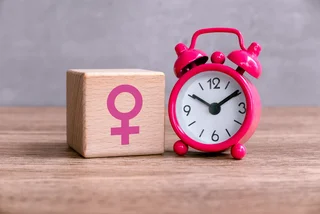International Female Orgasm Day, observed on Aug. 8, was first established in Brazil to honor women’s right to sexual pleasure. It began in the city of Esperantina when a local councilor dedicated the day to the female orgasm as a gesture to his wife. The holiday has since spread to countries like Spain, Mexico, Argentina, Peru, Norway, and, of course, here in Czechia.
The day emphasizes the importance of acknowledging female orgasms as equal to men’s. Global statistics reveal that only one-third of women consistently experience orgasms, making it crucial to recognize and address this disparity.
Throughout history, the Czech lands have made significant contributions to the advancement and normalization of women's sexual health in Czechia, showcasing the country’s role in promoting personal pleasure.
5 ways Czechia has celebrated the female orgasm throughout history
By showing it on film
Ecstasy, the 1932 film directed by Czech film director and actor Gustav Machatý and starring Maria Kiesler (later known as screen legend Hedy Lamarr), has long been considered the first non-pornographic film to portray a nude scene, sparking censorship issues worldwide. Lamarr, who was 19 at the time of filming, also courted controversy by performing one of the first on-screen female orgasms.
Despite this controversy, the film aimed for artistic innovation, with Machatý seeking to break from conventional filmmaking. When it debuted, the film won acclaim for its direction at the 1934 Venice Film Festival. A 4K restoration, led by Czech National Film Archives, debuted at the Venice Film Festival in 2019; it involved multiple archives to recreate the original Czech version, as the original negatives were lost due to efforts by Lamarr’s then-husband to suppress the risque reel.
Some scholars argue that while Ecstasy is indeed among the first serious representations of female pleasure in mainstream cinema, it was also a “two-edged sword of liberation and further disciplinary control.”
By conducting pionnering research
In the 1950s, Czech sexologists began pioneering research on the female orgasm, writes Radio Prague, during the communist regime in Czechoslovakia, outpacing Western counterparts. Triggered by studies on infertility, particularly at the Františkovy Lázně spa, researchers found a link between marital satisfaction and the ability to conceive. They concluded that emotional connection, rather than sexual technique, was key to achieving orgasm, with communication and equality in relationships being crucial.

Sociologist Kateřina Lišková highlights these findings in her book Sexual Liberation, Socialist Style, noting that Czechoslovakia’s sexual evolution was ahead of its time. Despite the repressive political climate, the 1950s saw significant progress in women’s rights, with the 1950 family law equalizing men’s and women’s rights. Czech experts even recommended sex therapy by 1963, predating similar movements in the West.
The societal backdrop included progressive laws that supported women in marital and family life, making Czechoslovakia’s approach to sexual health and gender equality unique and advanced for its era. This period of sexual research and equality in Czechoslovakia stands in contrast to the oppressive political trials of the time, marking a complex and progressive chapter in the country's history.
By creating a revolutionary sex-positive vibrator
The Whoop.de.doo vibrator, created by Czech designer Anna Marešová, revolutionized the market when it was released by blending erotic functionality with artistic design. Originating as Marešová’s master’s thesis, the product gained early acclaim, winning the 2011 National Prize for Student Design and the 2016 International Red Dot Award.
The vibrator stands out for its use of high-quality, flexible silicone, artistic aesthetic reminiscent of a Brâncuși sculpture, and its advanced features; it's rechargeable, waterproof, and equipped with three motors for customizable use. Marešová’s approach also emphasized women’s health, integrating feedback from gynecologists and sexologists and expanding the product line to include items like Venus Balls and a reusable menstrual cup.
The vibrator helped normalize the conversation around sex toys, positioning them not just as erotic aids but as tools for health and healing. The vibrator has gone a long way toward breaking taboos and making products like Whoop.de.doo widely accepted and recognized. The brand now has a showroom in Prague's Letná neighborhood.
By attempting to classify it
A 2022 study from Charles University in Prague identified three categories of female orgasms: wave, avalanche, and volcano. Using a Bluetooth-connected vibrator, the study analyzed pelvic floor contractions in 54 women. The "wave" is a short burst of contractions, the “volcano” involves a swift release of tension, and the “avalanche” features high contractions that taper off. The wave orgasm was the most common among participants.
The research builds on ideas from the 1966 book entitled Human Sexual Response. While the study sheds light on orgasm patterns, some experts caution against reducing female pleasure to just pelvic contractions, advocating for a broader understanding of sexual experiences.
Writer Stella Anna Sonnenbaum told Cosmopolitan: “It seems shallow to define the quality of orgasms simply via pelvic floor contractions.”
By giving it an empowering euphemism
Admittedly, this point applies to men as well. The philosophical euphemism for orgasms in Czech is believed to refer to the idea that an orgasm represents a state of existence and an affirmation of continued being – contrasting with the French notion of it as “a little death (le petit mort).”
In a 2016 study Behold, I Am Coming Soon! A Study on the Conceptualization of Sexual Orgasm in 27 Languages, published in the Journal of Metaphor and Symbol, researchers examined linguistic expressions of orgasm among native speakers of languages representing over half of the world’s population. Their work explored the words and phrases we use to describe this universal biological experience.
The website The Cut highlighted the Czech euphemism “Už budu,” meaning “[I] will be” as one of the most poetic descriptors of orgasm. “The Czech orgasm is seen as a state of existence and a commitment to continue being,” the publication writes. The study notes that Czech interviewees likened it to French philosopher René Descartes’ famous statement: “I think, therefore I am.” And The Cut jokes: "There’s nothing like indulging in a little death to make a person feel alive."












 Reading time: 4 minutes
Reading time: 4 minutes 





 English
(Advanced)
English
(Advanced) German
(Advanced)
German
(Advanced)


















